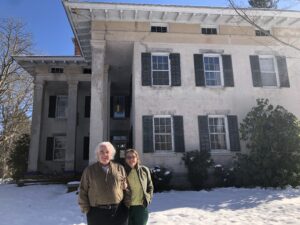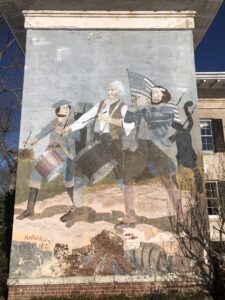By Alex Gerrish
The property at 37 Maple Avenue East in Higganum, Connecticut, has gone by many names—the Dooley House, Higganum Dairy, Spirit of ‘76 House, and most recently, Higganum House B&B. With each name change, the home assumed and embraced a new identity representative of the time, its owners, and the community surrounding it. Today, however, the house is commonly identified by the name of its original owner—Orrin Freeman.
The Orrin Freeman House is a large, two-story building characterized by its late Greek revival-style architecture. Adorned with brick faced with stucco, it was designed in a Tuscan Italian Villa style. Although it is most recently a bed and breakfast, the home served many purposes since its construction in the early 1840s. So, how did it end up with one of its most distinctive features—a giant mural of Revolutionary War soldiers?
What’s in a Name?
Based on a 1982 report compiled by the Greater Middletown Land Trust, Orrin Freeman—a lifelong bachelor, prominent businessman, and local entrepreneur—purchased the land for the home in the fall of 1841. Following the house’s construction (in either 1841 or 1843), Freeman cemented himself as a leader within Higganum.
Higganum’s location along the Connecticut River made it a hub for commercial activity. This area along the river, known as Higganum Landing, attracted immigrants from eastern and northern Europe due to its large shipbuilding operations and warehouses. According to the Haddam Historical Society, these warehouses made it possible to conduct “business with merchants in major cities including Boston, New York and Philadelphia.” Higganum’s early exports included timber, fish, and granite.
Freeman began his career as part owner of a brickyard near Higganum Landing started in 1810 by his father, Luther. Orrin later owned a lumberyard and sawmill with his younger brother, Luther A. Freeman, under the name O. + L. A. Freeman. This was, at the time, the largest operation in Middlesex County, supplying lumber for ships constructed at the Landing during the Civil War. This partnership was successful until 1862, when the brothers sold their company to local business partners Harris Cook and Alfred Brainerd, who operated under the name Cook & Brainerd.
Following this sale, Freeman continued to be a prominent figure in his community, retaining full ownership of the Middlesex Turnpike Company (prior to its return to town control) and serving as judge of probate in Haddam from 1855 to 1856 (losing eight subsequent elections almost a decade later). When Freeman died in 1880, The (Middletown) Constitution’s obituary described him as “one of the most prominent and energetic businessmen in this vicinity, and well-known throughout Middlesex County.”
Throughout the first 40 years of the Orrin Freeman House’s existence, it remained characterized by the man who made it famous, housing the legacy of a hardworking businessman. While this clarifies the legacy of the house’s name, it does not explain the Spirit of ’76 mural that adorns its exterior side.
Making The House A Home

Clark and Kamilla Gardner in front of the Higganum House (Orrin Freeman House) – Alex Gerrish, used with permission.
Following Freeman’s death, the Orrin Freeman House remained in the Freeman family until 1904 when Margaret and Edward Dooley of Brooklyn, New York, purchased the property. From 1892 to 1907, the Orrin Freeman House operated as a bed and breakfast under the name, The Dooley House. According to the Haddam Historical Society, “the Dooley’s [sic] would host New York visitors who would take the steamship up to Higganum from the city.” Although a departure from the house’s original purpose, this new identity celebrated the house as a center of business and cemented it as a landmark within the community.
A bookkeeper who grew up next door, Eugene Orlando Burr, later purchased the home in 1908 and it has remained in his family ever since. Within two years, Burr established a dairy farm on the property called Higganum Dairy—a reclamation of the property’s business roots. Burr died in 1942, but in the years following World War II, his daughter, Euphemia, and son-in-law, Francis “Bill” Gardner, moved back to Higganum. It was Gardner who provided the home with what today is one of its most distinctive features.
The Spirit of ‘76
In 1975, Bill Gardner painted a large Spirit of ‘76 mural on the southwest side of the building to commemorate the upcoming Bicentennial. According to Bill’s son, Clark Gardner, Bill was not an artist by trade, but rather a hard-working, patriotic man who found inspiration to paint the mural from his service in World War II. Gardner began his project on a gridded poster board and transferred it freehand to the stucco outside of the building using acrylic paint.
The mural itself is a replica of Archibald M. Willard’s 1870 painting, Spirit of ‘76. Willard’s painting was originally created for a Philadelphia exhibit during the 1876 centennial celebration. The painting, currently displayed in Abbot Hall in Marblehead, Massachusetts, was created to capture the spirit of the American Revolution—as understood a century later.
Willard attempted to find models that “[expressed] the courage and determination of the early patriots.” According to the Town of Marblehead, Willard modeled the central drummer after his father and the fifer after farmer-soldier Hugh Mosher. General John H. Devereux—the father of Henry K. Devereux, the model for the young drummer—purchased the painting in 1880 and donated it to the town of Marblehead, where it has been displayed ever since.
What began as a home for one of Higganum’s most prominent businessmen, today continues to encapsulate the narratives of both the local community and the families who called it home. A mainstay in Higganum, the home preserves its historic identity while also offering a blank canvas to those who aspire to shape its future. As people all over the country commemorated America’s two hundredth birthday in various ways—from wagon trains to the creation of new institutions to protests—Higganum found a way to make its own lasting contribution.
Alex Gerrish is the Programs Manager at the Noah Webster House and holds a B.A. in American Studies from Western New England University. The author would like to thank Clark & Kamilla Gardner, the Haddam Historical Society, and the Brainerd Memorial Library for their assistance with this article.










